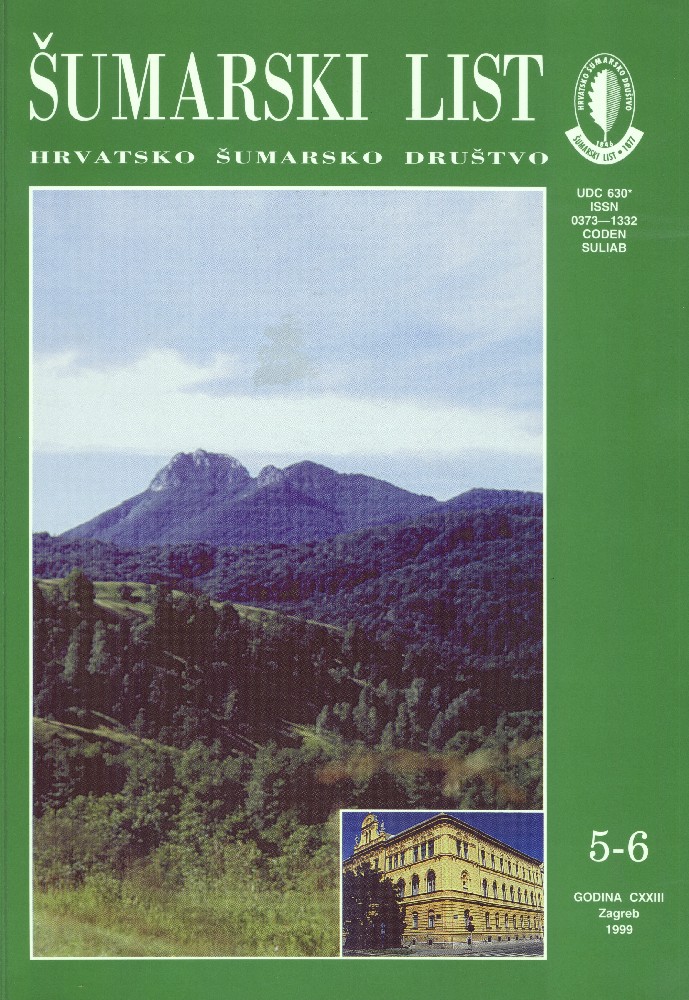
broj: 5-6/1999
pdf (23,4 MB) |
|
||||||||||||||
| IZVORNI ZNANSTVENI ČLANCI | ||
| Hrašovec, B., Harapin, M. | UDK 630* 450 + 453 (001) | |
| Survey Methodology and Most Important Insect Pest Outbreaks in Croatian Forests pdf HR EN | 183 | |
| Figurić, M. | UDK 630* 792 + 794 (001) | |
| Supplement to Discussion of Wood Processing and Furniture Manufacturing Development pdf HR EN | 195 | |
| PREGLEDNI ČLANCI | ||
| Martinić, I. | UDK 630* 969 | |
| Incentive for the Development of Safety and Health of Forestry Workers in Croatia pdf HR EN | 201 | |
| Glavaš, M., Margaletić, J., Baltić, M., Vuković, M. | UDK 630* 451 | |
| Dormice Injuries in the Forestry of Gorski Kotar Region (1972-1998) pdf HR EN | 211 | |
| Summary: There are three dormouse species that inhabit the mountain area of Croatia (Gorski Kotar, Lika): the fat dormouse (Myoxus glis L.), the forest dormouse (Dryomys nitedula Pall.) and the common dormouse (Muscardinus avellanarius L.). In Gorski Kotar, the most widely spread and the most numerous is the fat dormouse, specially in the fruitfull years of beech tree (Fagus sylvatica L.) whose seeds (beechnuts) are its basic food. The multiplication of dormice is extremely high during the fruitfull periods of beech tree, when they can cause significant damage to the forest trees.The artificially cultivated spruces (Picea abies (L.) Karst.) are specially endangered, while natural silver fir (Abies alba Mill.) and beech are less endangered. Damage occurs in springtime in the beginning of vegetation period and consists of biting off the bark, mostly at the upper third of a tree trunk. According to Delnice Forestry evidence, in the period from 1972 to 1976 in several spruce cultures of forestry unit of "Delnice" on the 50 hectares large area, over 8,000 spruce trees dried up because of the rings made by dormice. During the period between 1980 and 1983 in Ogulin forestry unit, in mixed coniferous and deciduous forests, the damage done by Myoxus glis was recorded on about 200 hectares. In the period between 1989 and 1998 the damage in Fužine area was recorded on 13 ha, in Delnice (1995-1998) on 9,50 ha, in Lokve (1995-1998) on 2,40 ha, in Ravna gora (1998) on 2,70 ha, in Crni lug (1998) on 12,52 ha and in Mrkopalj (1998) on 20 ha. The big dormouse is protected by law but is a game animal and can be hunted (Narodne novine, 61/1994), especially in the fruitfull years of beechnut. In so-called "dormouse" years the big dormouse is not jeopardized to be exterminated by hunting, since its population density increases very much then, and it is impossible to exterminate it totally. Intensity of damage depends on the fat dormouse population density. That density depends on environmental ecological factors, hunting and forest management. We suggest replacing artifical spruce cultures with species that naturally grow in those endangered areas. Key words: damages; dormice; spruce cultures; Gorski Kotar | ||
| Nodilo, M. | UDK 630* 270 + 272 | |
| Gardens of the Sacral Sights in Dubrovnik Region pdf HR EN | 217 | |
| PRETHODNO PRIOPĆENJE | ||
| Zelić, J., Benčić, P. | UDK 630* 231 + 561 ((Quercus robur L.) | |
| Local Population Experiment of Common Oak (Quercus robur L.) in Požega Valley pdf HR EN | 227 | |
| STRUČNI ČLANCI | ||
| Krpan, A. P. B., Šušnjar, M. | UDK 630* 859 | |
| Standardization of Forest Timber Products in Croatia pdf HR EN | 241 | |


